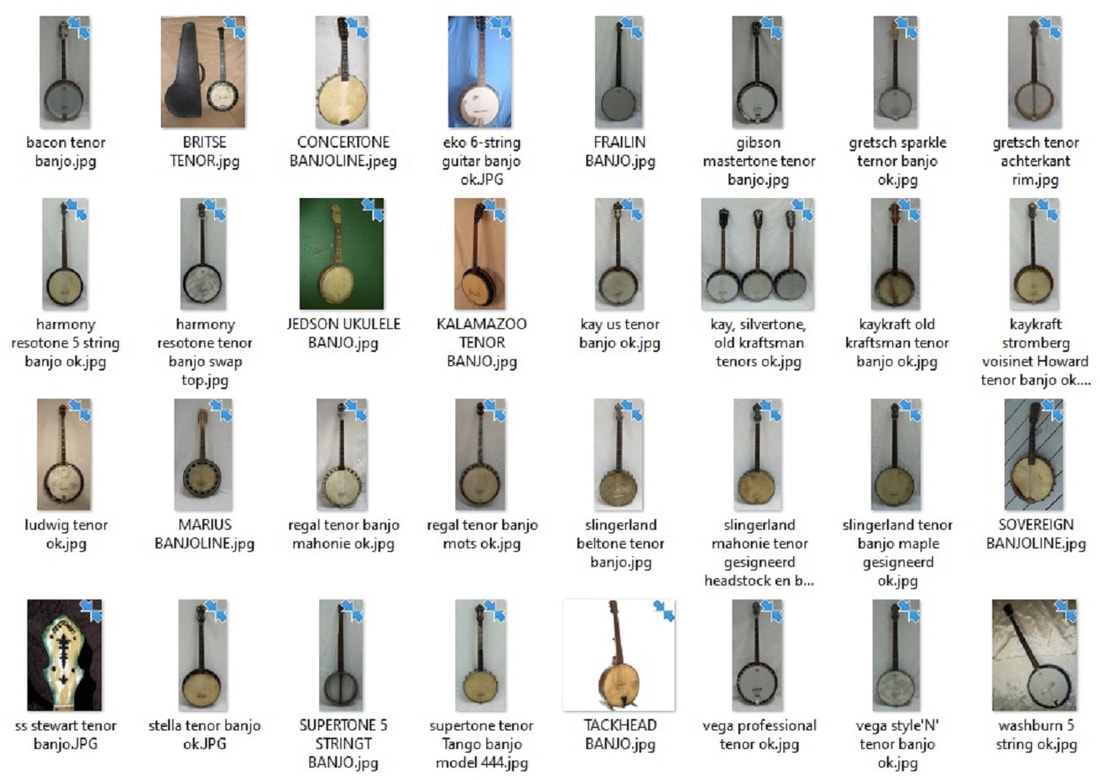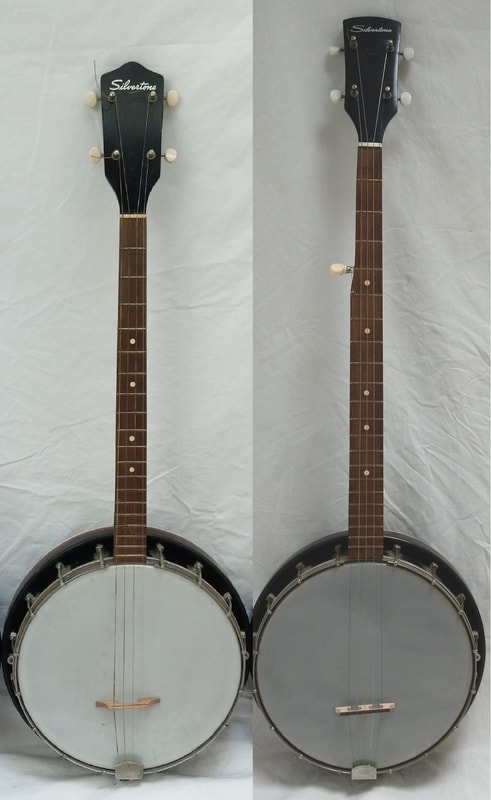Tenor banjos (1920-1970)
Towards the end of the First World War the mandolin lost its popularity in favour of the banjo, which was to play its roll in the early Jazz bands. But people didn’t go back to the five-string banjo that was in vogue before 1900. They turned towards a new instrument that was closer in technique to the mandolin: a four string banjo tuned in fifths, with a more or less short neck, played with a plectrum like the mandolin: the tenor banjo was born.
The numbers of production of budged or mid range instruments in the 1920s are simply amazing, only to be equalled by the amount of guitars from the same period. These banjos, in spite of their low buying prices, say under 100 $, technically and musically perform well, and in some cases even better than the overloaded fancy instruments only few could afford. Between 1930 and 1950 the banjo was somehow forgotten, but then people started to rediscover it. In the early ’sixties the rising popularity of folk and "bluegrass" music brought about a change in demand, and the companies principal banjo productions were devoted to 5-string and extended neck instruments, although tenor-banjos and plectrum-banjos continued to be made. . |
TWO STORIES, TWO COLLECTIONS
Gibson Mastertone tenor banjo TB3
|
This Style 3 tenor banjo has a red-stained maple neck and resonator, single white binding on the fingerboard, a Presto tailpiece, a two-piece flange with nickel plating, a fiddle-shaped peghead and diamonds and squares inlay.
The company started with nothing in 1918, the year the TB (for Tenor Banjo) appeared. In May, 1923, Gibson introduced a new banjo, they added a tubular tone ring, and surmised that contact with the rim would have a deadening effect, so they limited contact between the two to a minimum. The new Gibson banjo also came with a resonator, not original on this one. Many different models and different types of tone rings and resonators were developed during the years. Although the domination of tenors (TBs) ended after the Second World War, the pre-war Gibson Mastertone tenors are still in high demand today because the neck can easily be replaced with a five-string neck. |
Bacon tenor banjo
|
Lange’s resonator, finally patented in 1925 became the industry standard. Other companies rushed to market competitive instruments. Bacon and Day introduced their flange-resonator “Silver Bell” model in 1923.(zie verder: (Ring the banjar p. 27-28) This four-string tenor banjo was made somewhere around 1930 by the Bacon Banjo Company from Connecticut, who built many of the finest banjos of the 1920's and 1930’s (a.o. the “Silver Bell” models). Like most banjos of this brand it has 24 rounded hooks, a metal tone ring and a wooden resonator with a turned profile on the back.
Fred J. Bacon started the company in 1920. Two years later, David L. Day left the Vega Company to join the Bacon Banjo Company. In 1940, the B&D Company was purchased by the Gretsch Company who continued to make Bacon and B&D banjos until the late 1960s. |
Stromberg-Voisinet and Kay tenor banjos
|
The banjos made by Stromberg-Voisinet (later Kay) are quite recognisable. Two headstock profiles are typical and can also be found on their guitars and mandolins, one symmetrical with a central pointed top flanked by two S-shaped ends, the other asymmetrical with an S-shaped top, flanked with semi-circular cut-outs.
Inside some banjo pots sometimes a paper label is glued on the wooden rim referring to Stromberg-Voisinets patented neck adjustment system. A wooden or metal plate is tacked to the banjo rim to keep the neck from twisting or rotating. It has a concave surface and a groove at the side of the neck. The neck rides on this track and is attached to the rim by a screw that goes through the heel cap and the heel into the rim rod. By loosening this screw the angle and the height of the neck can be adjusted. This system is common to most Stromberg-Voisinet and Kay banjos and many of their pre-war guitars. The 27,3 cm tone ring generally is a metal round profile rod that’s bent to a circle and fits in a groove on top of the banjo pot. The resonator fronts are perforated following a pattern of dots and stripes. They’re attached by a screw through the centre of the plate or by two screws and vices fixed on the inside of the sides. |
Slingerland tenor banjos
|
The banjo giant “Slingerland Banjo and Drums”, was based in Chicago, and at least as prolific as Kay and its ancestors. Since the start of their banjo division in 1918, only two years after the companies formation, they enjoyed a large sale of well made and very affordable tenor and plectrum banjos all over the world. After the depression of 1929 the Slingerland company stopped making banjos and reverted to its main object of drums and drum accessories. It’s again the shape of the banjo headstock that operates as a signature, and at times there is a branded mark on the wooden dowel stick, Especially the May Bell name is widespread and can also be found on more fancy models by Slingerland and on their guitars. The simple rim (26,7 cm) has a flat surface with the superposed tone ring held in place by the pressure of the banjo top.
|
Gretsch tenor banjos
|
Again the headstock shape is the distinguishing mark for one specific type of Gretschs budget banjos. It’s often decorated with a small “mop” circle with four small stripes crosswise near the edges (left). Some Gretsch banjos have sparkle coatings, exactly like the ones applied on their drums (right).
|
Regal tenor banjos
|
Although Regal is not particularly known for its banjos, the company did produce some fine specimens in the first decade of the previous century. Between 1928 and 1939 they produced tenor banjos with shoe flanges patented by Albert Hunter on May 15th 1932. Unfortunately these were often made of cheap "pot" metal that became brittle over time. So it's quite rare to find specimens like these two, with a complete set of flanges.
|
Vega "Professional" and Ludwig "Kingston" tenor banjos
|
Vega and Ludwig may have made banjos for other companies and baring other names, but they’re not as abundant as the ones we discussed before. Like Gibson, they preferred to concentrate on professional grade instruments under their own name and they each developed their own systems for the flange, tone ring, tension hoop and resonator combination. Although 5 strings are more sought after these days, most banjo's coming out of these factories in the 1920's were tenors.
|
Stella tenor banjo and Supertone "tango" banjo model 444
|
Stella guitars were generally known in the first half of the last century, but this company also manufactured budget banjos with decals that often differ little from those used on their guitars.
The Supertone banjo in this collection has been provided with an "E-Z players"by Ferry & Co in Chicago around1925. This keyed device, patented in 1921, should allow non-musicians to play tunes on the banjo without any musical knowledge. |
Harmony resotone tenor and 5-string banjos
|
Harmony re-commenced in the 1950’s when the banjo started to be played again. The company
developed an entirely new process of making hoops which involved a moulded resin plastic, self reinforced at key points and called them "Reso-Tone". The company also markets a resonator of the same plastic material. In the early ’sixties the rising popularity of folk and "bluegrass" music brought about a change in demand and the company’s principal banjo production was devoted to 5-string and extended neck instruments, although tenor-banjos and plectrum-banjos continue to be made. |
Kay tenor and 5-string banjos
|
In the Kay factories banjo manufacture was resumed in the 1950’s. Models included five-string banjos, tenor-banjos and plectrum-banjos. These were sold under their own name , but many were branded "Silvertone" (by wholesailer Sears) or "Old Kraftsman" (Montgomery Ward).
|
© COPYRIGHT 2015. ALL RIGHTS RESERVED.










